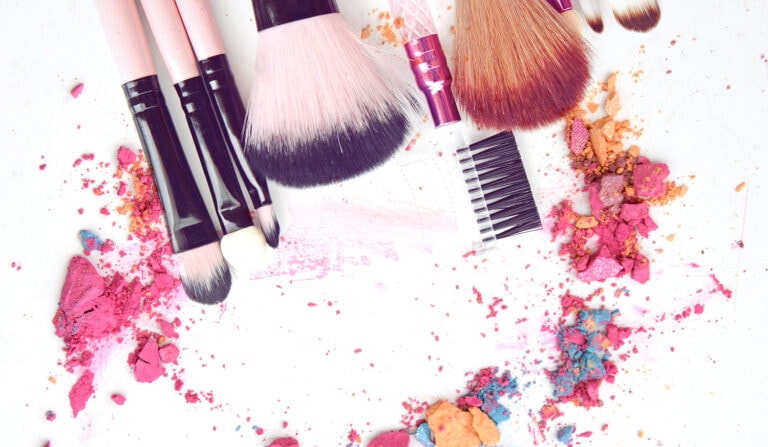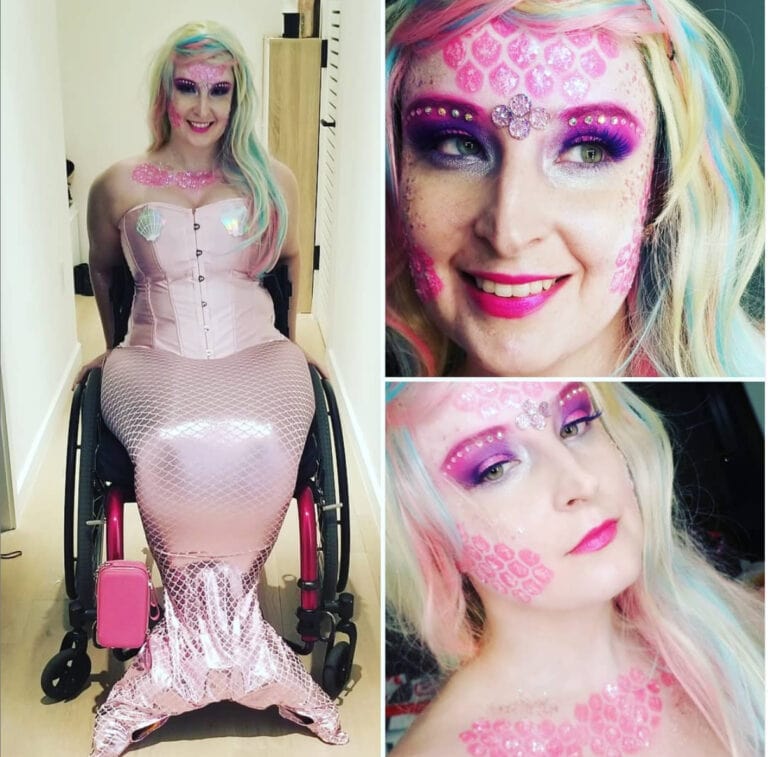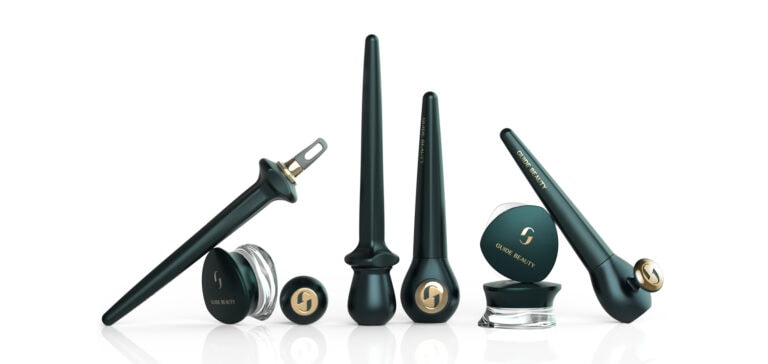
Lucy Richardson is conflicted about some free makeup swag she was given recently. Richardson, the founder of Wheel New Yorkers, is also a makeup enthusiast who regularly visits places like Sephora and Ulta Beauty. Rolling into the unnamed business was not an extraordinary event for her, but as she explained to NEW MOBILITY, “The manager of the store was so taken aback by me coming in there with my fashionable outfit and makeup that they gave me a bag of free products.” She accepted the products and went on with her day but shared with the manager what actually went through her mind in the moment: “I’m glad I got this, but I’d also be pretty cool with you not having weird ideas about disabled people.”
Richardson’s experience exposes more than just one person’s obliviousness about disability. It’s indicative of the ableism embedded in every aspect of the cosmetics industry, from ignorant and unwelcoming retail spaces to inaccessible product design to lack of representation in advertising. The journey toward true inclusion is long and slow, so disabled makeup lovers create hacks to adapt products and tools to their abilities.
One hack is to put a rubber band around a Beautyblender so that gripping it is easier. Another is to use a magnifying mirror for improved visibility. Richardson, who has a rare degenerative motor neuron disease, goes further than these basic tips so she can apply intricate details to her friends’ makeup without her hand getting tired.
“What I would do is try and pinpoint which aspect of applying makeup I found difficult and then find a solution for it,” she says. “So, for winged eyeliner, I would get a straight line, and then I’d shake and it would move.” She solved that problem by using winged eyeliner stamps. She also uses a drugstore brand of transparent tape on her face to achieve a straight line. Since there is less adhesive on it than a better brand like Scotch, it’s easier to rip off and it doesn’t hurt. Also, she converted a wrist rest meant for keyboards to an elbow rest for doing her own makeup and requires anyone she does makeup for to hold out their hands so she has a place to rest her arms if she needs it. She recently did makeup for all of the guests at her brother’s small wedding using these techniques.
“I try and pinpoint which aspect of applying makeup I find difficult and then find a solution for it.”
Products exist for makeup artists and beginners to assist with application, but it takes digging to find them and very few are specifically marketed toward the disability community. It’s disappointing to Richardson, who has seen the cosmetics industry growing toward expanding its ideas about the “typical” customer to include many other groups of people recently.

Photo courtesy of Brenda Gutierrez Baeza
Brenda Gutierrez Baeza wishes there was better technology to help her apply makeup.
“I look at the kind of products that are coming out and there are all these really exciting developments in the kind of ingredients that people are using and the types of application,” she says. “And I’m seeing things about diversity and inclusion in terms of shade range that is available for foundation and concealer and that kind of thing. And I’m seeing men and nonbinary people being embraced and, you know, it’s the same as happens in a lot of spaces where it’s like, ‘Yeah, that is fantastic, let’s do more of that. But could we be part of it, too?’” She has found a few potentially useful products on GoFundMe pages, but that doesn’t necessarily mean they are ready for purchase or universally available.
Lucy Richardson’s makeup skills made her Halloween mermaid costume elegantly fantastical.
Simple Adaptations
Some of the adaptations wheelchair users would like to see are simple. Brenda Gutierrez Baeza is a member of the County of Santa Cruz Commission on Disabilities in California. Her disability restricts the mobility in her arms, so she dictates her makeup looks to her family and friends, who apply it for her step-by-step. She uses a Kinova Jaco Assistive Robotic Arm to help her do things like open doors but only has one device. “I was hoping that I’d be able to do my makeup with it,” she says. “With most makeup products, you need two hands to unscrew a cap or twist the mascara bottle or whatever. So I wasn’t able to do much of anything with my robotic arm. It would be nice for more products to come out for people with one arm so that it’s easier for people to apply makeup without needing two hands.”

Guide Beauty founder Terri Bryant made it her mission to create inclusion in the cosmetics industry after being diagnosed with Parkinson’s disease. She is a makeup artist and educator who has created education-based programs for brands like Smashbox and Christian Dior. When hand tremors threatened her ability to do her own makeup as well as makeup for clients, she refused to accept this reality without searching for a practical solution first, even if she had to create it herself.

Photo by Mitchell Guerrero
Guide Beauty cofounder and creative director Terri Bryant designs makeup tools that are stable and easy to grip.
Bryant developed prototypes for Guide Beauty tools at home and eventually developed a wand that looked like “a little finger puppet” to make it easier for her to apply mascara. She knew from her years of educating others on makeup application that what she created would help others, too. Her diagnosis gave her a completely new viewpoint to build a brand around.
“All of a sudden I landed in this unique perspective. I understand what it feels like to be a professional makeup artist and have that very natural, effortless movement with my arm. And now I could understand what it feels like to have to disconnect,” she says, adding that makeup artists are usually the people invited into the room to develop application tools, which doesn’t help the average user, disabled or not.
True Inclusion
Though wheelchair users are not the exclusive target customer for Guide Beauty products, Bryant took the company’s quest for true inclusion seriously. When it came time to develop the products in the lab, she worked with a team that specialized in universal design. The goal was to “cast the widest net possible” with test users of all different abilities from a professional makeup artist to someone with rheumatoid arthritis or multiple sclerosis, for example. The team gave 200 testers traditional application tools and watched for what Bryant called “sticking points” in their process to figure out how to make tools to solve the biggest, most frequent problems for people with a variety of experience applying makeup.
“The two greatest human factors we could really leverage in elevating the design were grip and stability,” Bryant says. “Now, when you look at a lot of traditional tools in makeup, you’re looking at these thin cylinders that encourage you to have a tighter grip that sort of locks up … if you’re even able to grip. Some people can’t grip. But if you can grip that, what does that do to the whole arm, and is that comfortable?”
Stability is an issue if your hand is not rock steady. “If you watch people apply makeup, no matter skillset or ability, they’re always looking for ways to sort-of match the ground and steady their hand for application,” Bryant says. “So we thought if we could build stability into the tools, if we could build those touch points that made it more comfortable, and if we could free up the hand and the grip, it would enhance the experience for everybody. Specifically, it would help people who couldn’t play in the world of makeup without doing that [holding a tool steady].” Guide Beauty produces a Lash wrap tool for applying mascara, a tool called Brow Moment for filling and shaping eyebrows, the Guide Line for eyeliner application, and unique eyeliner and mascara formulas.

Each tool has a “Guide ring” protruding from it that allows the user to loosely grip the wand with two fingers. This leaves the hand free to have a “lighter, softer” motion, explains Bryant. This also makes it easier to adjust your hand and steady yourself if needed. The Guide Line wand is also designed to allow the product to be applied vertically instead of horizontally so that your arm is closer to your face while applying it.
Bryant also paid attention to elements of her products that don’t seem to matter to accessibility on the surface — like product formulas and the thickness of the mascara wand. Guide Beauty’s wand is thin because Bryant said it’s a myth that fatter wands make for easier application. “Sometimes those bigger brushes [make it] harder to get to the base of your lashes. And so you’ll end up hitting the lashes too high and weighing them down. And then they don’t hold that nice, pretty curl that you want.” She values “thoughtful moments” in formulas. So, Guide Beauty’s mascara holds like it’s waterproof, but won’t damage your lashes like too much waterproof mascara does or smudge like a traditional mascara.
There are only a few Guide Beauty products in the complete line at the time of this writing and many of them focus on the eye. Bryant’s dream is to create enough tools and formulas so that customers can have what she calls “the full Guide Beauty face” eventually.
Her development process might be slower than other cosmetics companies because she is committed to complete inclusion of people with all abilities at every stage. “If you feel like a product wasn’t really designed for your needs, then why would you even bother to pick it up to begin with?” she asks.

Photo by Darien Davis
A model applies makeup using Guide Beauty’s Guide Ring.
She would like the cosmetics industry to dispel the notion that every makeup consumer should be able to pick up a product and automatically know how to use it. If companies take more responsibility for the usability of their product, physical accessibility could increase. For Bryant, another easy way to organically create true inclusion for people of all abilities in the beauty industry is to include people of all abilities in every aspect of product development from brainstorming the product to advertising it.
Makeup enthusiasts like Baeza and Richardson are also looking for tangible changes within their favorite cosmetics retailers like more space in the aisles, lower shelves, products that are easier to open, and mainstream attention for adaptive products. Baeza has a challenge for AI experts that dabble in the world of cosmetics. “If we want to picture a perfect world where anything is possible, then I would love to have a robot that does your makeup,” she says. Why shouldn’t she dream that big? There are robots that help people with mobility issues eat independently. We deserve ones that help us feel beautiful, too.
Support New MobilityWait! Before you wander off to other parts of the internet, please consider supporting New Mobility. For more than three decades, New Mobility has published groundbreaking content for active wheelchair users. We share practical advice from wheelchair users across the country, review life-changing technology and demand equity in healthcare, travel and all facets of life. But none of this is cheap, easy or profitable. Your support helps us give wheelchair users the resources to build a fulfilling life. |


Recent Comments
Bill on LapStacker Relaunches Wheelchair Carrying System
Phillip Gossett on Functional Fitness: How To Make Your Transfers Easier
Kevin Hoy on TiLite Releases Its First Carbon Fiber Wheelchair